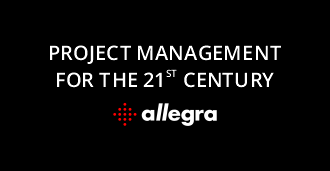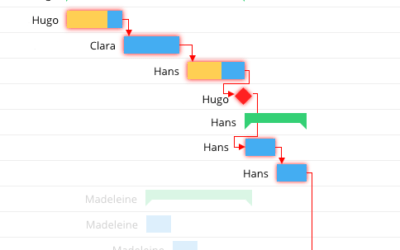Need Task Management Software but Unsure What’s Essential?
Overview
Are you looking for task management software, but you’re unsure about what exactly you need to help your team do its best work? This article will teach you a little bit about task management and what we think task management software should include.
Task management software is designed to help users collect, structure and process their tasks. In this post, I’ll show you the different categories of task management solutions and explain their main features, so you know what to look for.
We can divide task management tools into two classes:
- Personal productivity tools
- Team-oriented collaboration tools
The first class has evolved from notebooks and other analog productivity management tools such as Filofax and Time System. The second class originates from software developers’ bug tracking systems. The distinction is not always clear, as many vendors have subsequently added collaboration features to their personal solutions.
Task Management Software for Personal Use
For personal relief, many people use to-do lists to record what they need to get done. Some use a notebook for this, others use their smartphones. There are a lot of applications for this purpose. They differ in their scope of features, the way they integrate with other tools, and how they store their data.
Today, it is common practice to store such personal task lists in a cloud environment, so that they are available on all devices. Operating systems like Android, iOS and Windows already have simple applications pre-installed that can be used for this purpose.
But if your pre-installed Apps aren’t giving you what you need, there are more powerful task management tools for this purpose. The most popular are:
- Things for Mac and iOS
- Todoist
- Outlook Task Manager
These solutions are characterized by the fact that they allow a better categorization and structuring of tasks and partly implement the basic ideas of the Getting Things Done method (see below). In addition, some of these tools offer simple team support so that you can delegate or view tasks.
Task Management Tools for Teams
Since hardly anybody today can work alone, task coordination between team members as well as communication play an important role. Thus, for project collaboration, it is not enough for everyone to keep their own personal task lists. Others need to know about the processing status of tasks. We need to be able to delegate tasks easily, control them through a workflow, and make them accessible to a limited group of people. You can read about the best tools for collaborative task management here.
Which Performance Characteristics Do You Need in Task Management Software?
Ultimately, that’s up to each person to decide. However, we can give you our essential list:
- Custom attributes: Sooner or later, you’ll need additional categorization capabilities, not just tags and labels.
- Role-based access protection: Access other team members’ tasks must be configurable via roles and permissions; user level and the like is not enough.
- Storable complex filters: Simple sorting or filtering by individual attributes is insufficient.
- Support of the Getting Things Done method: This includes, for example, possibilities for resubmission and delegation.
- Support of the RACI matrix: There is nothing better for systematic responsibility assignment.
- Eisenhower principle: Two very important factors, importance and urgency, are combined for clear prioritization of tasks.
In addition, there are performance features that will be important as your number of tasks increases. These include:
- Hierarchical tasks: This is necessary in project work so that you can create a project plan, for example. Simple sub-tasks are insufficient.
- Workflow Automation: As soon as your organization involves more than a few people, you need to control and automate workflows.
- Support for agile practices: A task board, Kanban board, and burn charts are popular representations of tasks in meetings.
- Powerful application programming interfaces and integration capabilities
The Getting Things Done Method
Getting Things Done (GTD) is a method for personal task management according to David Allen. GTD is also a great method for your team. As we all know, stuff appears in our thoughts, on our desks, or on our computers during the day. We can also refer to stuff as tasks.
Examples of stuff are tasks, open items, bug reports, ideas and customer requests. Recipients cannot directly influence their inflow of incoming tasks, but they can sort them when their task management software supports GTD.
With a program like Allegra, all incoming tasks are first collected in the personal inbox, which is a type of basket. Then, stuff we receive there is regularly analyzed. There are three possible outcomes of this analysis:
- A task is “actionable.” You need to do something about it.
- It is “not actionable.” Maybe, you need to note it and possibly file it somewhere, but it is not urgent.
- It requires a sequence of actions. This possibly involves several people over a long period of time, which necessitates planned actions. Scheduled tasks within planned actions can be, for example, a work breakdown structure for a project or a Scrum product backlog.
Actionable Tasks
For actionable tasks, you have three baskets:
- Next actions: Here, you can place tasks that you want to work on in the near future. There is no real planning or deadline for next actions. If you have deadlines or dates in mind, then you should place these tasks in the calendar basket.
- Calendar: This is where you can place all time-dependent tasks, such as an appointment or a meeting. The calendar basket contains three types of actions: Appointments, Actions, Day, and Day-specific information.
- Delegated/waiting: This basket contains tasks that you have given to someone else.
Not Actionable Tasks
For elements that aren’t actionable, there are also three baskets:
- Garbage: You will not further consider these tasks. You can delete them.
- Incubator: Tasks that do not require action at the moment are placed here. You might consider them later, but maybe not. These tasks can serve as the basis for future work. A few examples are ideas, wishes, improvements, etc.
- References/Favorites: This basket contains material that may one day be important or you need to frequently check up on, e.g. FAQ, requirements, standards, etc.
Planned Operations
You should review the basket for planned operations regularly. You can move these operations into one of the actionable baskets, if need be. This helps you keep your plans in sight.
The RACI Method
Clearly defining responsibilities is necessary for task management in every project. Regardless of team size, everyone must understand their assigned role. In other words, everyone must know which activities and tasks they are responsible for. A good task management software will make this easy for you.
One way to define the role of each team member is to use a RACI matrix. The RACI matrix is a diagram system that names specific team members who are involved in each task. The categories are: Responsible, Accountable, Consulted, and Informed. Explicitly stating roles eliminates confusion about responsibilities and increases project efficiency. Thus, by using a RACI matrix, we can make faster decisions, our accountability is clear, and workload is evenly distributed.
RACI informs us about our team members’ workload because it shows which role(s) each person has in relation to a task. For example, we can see whether a team member has been assigned to the responsible role too often. In other words, we can check up on which people have too many or too few tasks to perform. Additionally, if someone completed a task incorrectly, RACI tells you who was involved and ultimately responsible.
Because everyone is involved when your team uses RACI, your team will efficiently complete projects. In short, RACI makes it easier for you to have the right conversation with the right people. Everyone saves time.
The Eisenhower Principle
The Eisenhower principle offers four categories that we use to schedule tasks for processing. It teaches us that we must distinguish between urgency and importance when completing tasks. Here are the four categories:
- Important and urgent: We need to do these tasks first.
- Not important and urgent: If possible, we should complete these directly afterward important and urgent tasks, if possible.
- Important and not urgent: Occasionally, you can do these tasks.
- Not important and not urgent: You don’t really need to worry about these.
Many task management tools offer the possibility to prioritize or tag tasks. You can often configure priorities. It would help you and your team take the time to do this.
Want to Learn More?
Hopefully, we’ve given you a better idea of what you need in your task management software. If you want to learn more about these task management methods, please click here. Or, if you want to learn more about the difference between task management and project management, check out this article on project management vs. task management.



